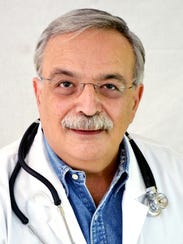Jan 15, 2015
Jason Roberts, Clinical Marketing
(article courtesy of the Democrat & Chronicle.)
URMC to study HIV and heart disease
Patti Singer, staff writer for the Democrat & Chronicle
A 50-year-old person living with HIV and being treated with anti-retroviral drugs may have the blood vessels of someone much older — with the heart disease and stroke risk to prove it.
"We're trying to understand how that happens," said Dr. Giovanni Schifitto, a University of Rochester Medical Center neurologist who is co-leading a $3.8 million study into premature vascular aging among HIV-positive individuals. "How is it possible? What is the drug doing that may be facilitating this aging of the blood vessel?"
Schifitto is part of a team of doctors and engineers in a $3.8 million study funded by the National Heart, Lung and Blood Institute who will use blood work and a new imaging technique to look at the neck artery. The team consists of three other UR researchers and one former URMC researcher now at M.D. Anderson Cancer Center in Texas.
In addition to combining medicine and engineering, the study also teams clinical and basic scientists in a different sort of collaboration.
Normally, the basic researchers perform their lab work, and those results help the clinicians treat patients. In this case, the researchers working with patients will send their results to the lab, so those "bench" scientists can use that information with animals to test potential new therapies that spare the blood vessels.
"This is really digging a bit deeper with our understanding of HIV disease," said Dr. William Valenti, senior vice president for organizational advancement and staff physician at Trillium Health, which is helping to recruit volunteers. "We've been able to bring it under control. Can we do it better? … It's actually an evolution in the understanding of HIV and how it should be managed."

Dr. William Valenti(Photo: Provided by Trillium Health)
Rochester has the second highest HIV infection rate per capita in the state, outside of New York City, according to Trillium Health. The organization reported that about 2,000 people in the Rochester area are living with HIV. URMC and Trillium provide treatment for people with HIV.
In the study, 180 HIV-positive and 90 HIV-negative individuals who are at least 50 years old will be followed for three years. Schifitto said the groups would be matched as closely as possible for lifestyle or other environmental factors that could affect their cardiovascular risk.
Advances in treatment have increased lifespans and led to the realization that people with HIV face the same diseases of aging as people without HIV. But they are facing them earlier.
"By HIV definition, anyone age 50 or older is considered an older person, compared to general population," Schifitto said. "We think the effect will be easier to observe than those who are young."
In the general population, one in four deaths is related to cardiovascular disease. It can be difficult to make direct comparisons between cardiovascular disease in people without HIV, where "older" usually is defined as 65 and beyond, and people living with HIV. Nevertheless, researchers have found a 50 percent increased risk of death from CVD among HIV-positive people.
Schifitto said people with HIV also face the traditional risk factors of high blood pressure, diabetes and obesity for heart attack and stroke. The question is, does HIV treatment hasten the development by somehow promoting inflammation? Or is it just part of the HIV process?
"The idea is to try and sort it out," Valenti said. "Is it the presence of virus even at low levels and/or the drugs that are contributing to this? Then you're in a better position to try and do an end run around the inflammation, presumably with better drugs that are more effective at keeping the virus under control and also less likely to contribute to this inflammation. It's interesting they're doing the lab piece and the patient piece simultaneously. It's a very novel approach, one that is designed to get to an answer a little bit faster."
Schifitto said that in addition to using existing ultrasound to look at the thickness of the carotid artery, the scientists will use a new type of ultrasound developed by Marvin Doyley of the UR Department of Electrical and Computer Engineering to measure the stiffness of the artery.
"This technique is more sensitive than looking at thickness," he said. "We'll look at whether the elastic properties change earlier than we speculate. Our hypothesis is they will be changing earlier."
Schifitto said the researchers also will look at blood cells to measure compounds called oxidants and to see whether the cells are functioning properly and how any changes might be related to the stiffness or thickness of the carotid.
PSINGER@DemocratandChronicle.com
Twitter.com/PattiSingerRoc
